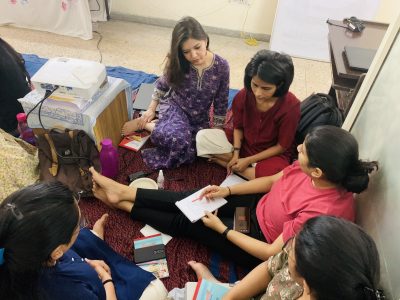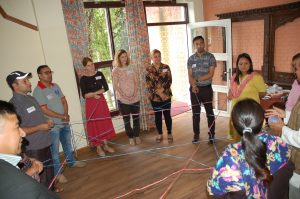Linda DeWolf (GoPhil Co-founder), Emily Bild (GoPhil Director of Programs) and Rith Sarakk (former Executive Director of PEPY Empowering Youth) were very fortunate to be invited to lead a session at the Council on Foundations annual conference last month – and we very much enjoyed working together to brainstorm ideas and prepare for and host the event!
 One of the themes of the conference was ‘Raising the Bar’ which included sharing strategies, resources, and tools to help philanthropic leaders be agents of change in their organizations and communities. With that goal in mind, we chose to focus our session on the journey GoPhil has been on to help address power imbalances and shift power to grantee partners. We had a great discussion around strategies that GoPhil has tried in this space as well as PEPY’s experience with funders – what helps promote sustainability for them and the kind of support most helpful to a community-based organization. We also shared lessons learned, challenges, and outcomes from our ongoing journey towards greater equity, self-reliance, and shared power.
One of the themes of the conference was ‘Raising the Bar’ which included sharing strategies, resources, and tools to help philanthropic leaders be agents of change in their organizations and communities. With that goal in mind, we chose to focus our session on the journey GoPhil has been on to help address power imbalances and shift power to grantee partners. We had a great discussion around strategies that GoPhil has tried in this space as well as PEPY’s experience with funders – what helps promote sustainability for them and the kind of support most helpful to a community-based organization. We also shared lessons learned, challenges, and outcomes from our ongoing journey towards greater equity, self-reliance, and shared power.
As part of this session, we worked together to prepare a short handout, detailing 10 practical steps funders can take to help #ShiftThePower in philanthropy and development. We have shared this below and welcome any feedback, suggestions, or ideas as this is very much an ongoing learning space for us!
We look forward to engaging with our community and networks more on these important issues, as we continue our learning journey together.
10 Practical Ways to #ShiftThePower
1. Find the right partners: Ensure the partner organizations you support are deeply rooted in their communities, responding to communities’ needs and priorities, and are tapping into local resources and networks.
2. Adopt a ‘Listen and Learn’ approach: Do not enter the funding relationship expecting to offer advice or guidance. Your partners are the experts in their community and their work. Your role as a funder is to listen deeply to them and learn what you can do to best support them.
3. Focus on your partners’ needs and vision: Likewise, do not expect to be setting the agenda or designing programs. Trust your partners to know what will work or not work in their communities and listen carefully to them to understand their needs and vision for their work. Then look for ways you can help them address those needs and achieve their vision.
4. Support core funding needs: Most grassroots organizations struggle to raise funds for core running costs, such as staff salaries, staff training, rent and utility bills. Yet these are all essential to the quality of their programs. Funding these line items – as opposed to limiting funding to being project-based – is key to creating stronger and more sustainable organizations.
5. Involve your partners in strategic planning and processes: Create space for your partners to provide input into your strategies and plans, for example through a partner Advisory Panel. This will not only empower your partners, but will also help you to make better decisions as you have the opportunity to hear directly from different stakeholders.
6. Commit to flexibility: Ensure you are flexible in terms of reallocating funds and in your communications and reporting expectations, particularly during crisis situations. A good starting point for this is to take the Council on Foundation’s pledge, signed by 800 organizations in the past year.
7. Build trust: This takes time, but reaching out regularly and being open in your communications, checking in on partners when they are facing challenges, relying on catch up calls rather than written reports, are all key to building trusting relationships. This, in turn, leads to greater honesty and openness, so partners feel comfortable sharing their challenges as well as successes.
8. Offer more than just funds: Organizations need funds in order to achieve their goals, but they often require non-financial support too – opportunities and spaces to share their work more widely, leadership training, capacity building support for their teams. Take time to find out what partners need in order to achieve their visions and goals and help them access that support.
9. Promote cross-learning: Provide opportunities for your partners to network with others and learn from each other. Organizations all have strengths, skills, expertise and experience in different areas. Connecting your partners to each other allows them to support one another, and to share lessons learned and best practices. Building this solidarity also allows organizations to feel less alone in the challenges they face.
10. Create opportunities for feedback and improvement: Be a learning organization and open to receiving criticism and suggestions! Ask your partners what you could do better or more of, what is helpful to them and what is not. Creating feedback mechanisms (such as anonymous partner feedback surveys) allows you to continuously learn and improve as a funder and strengthens the effectiveness of your work.

Key Resources
Smart Risks: How small grants are helping to solve some of the world’s biggest problems? Edited by Jennifer Lentfer and Tanya Cothran
https://ssir.org/articles/entry/three_ways_to_improve_diversity_equity_and_inclusion_in_philanthropy#
For more information contact:
[email protected]
[email protected]
